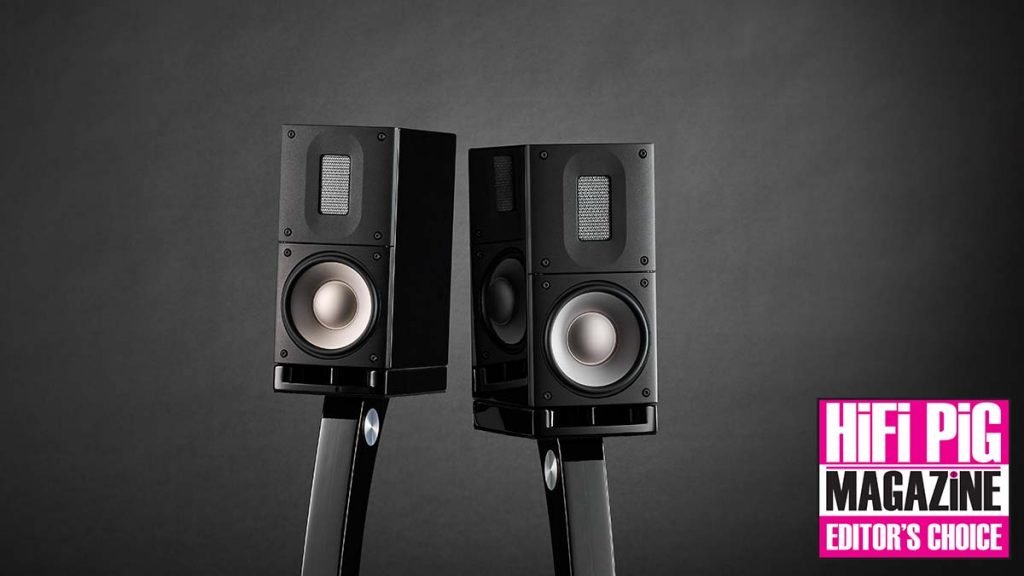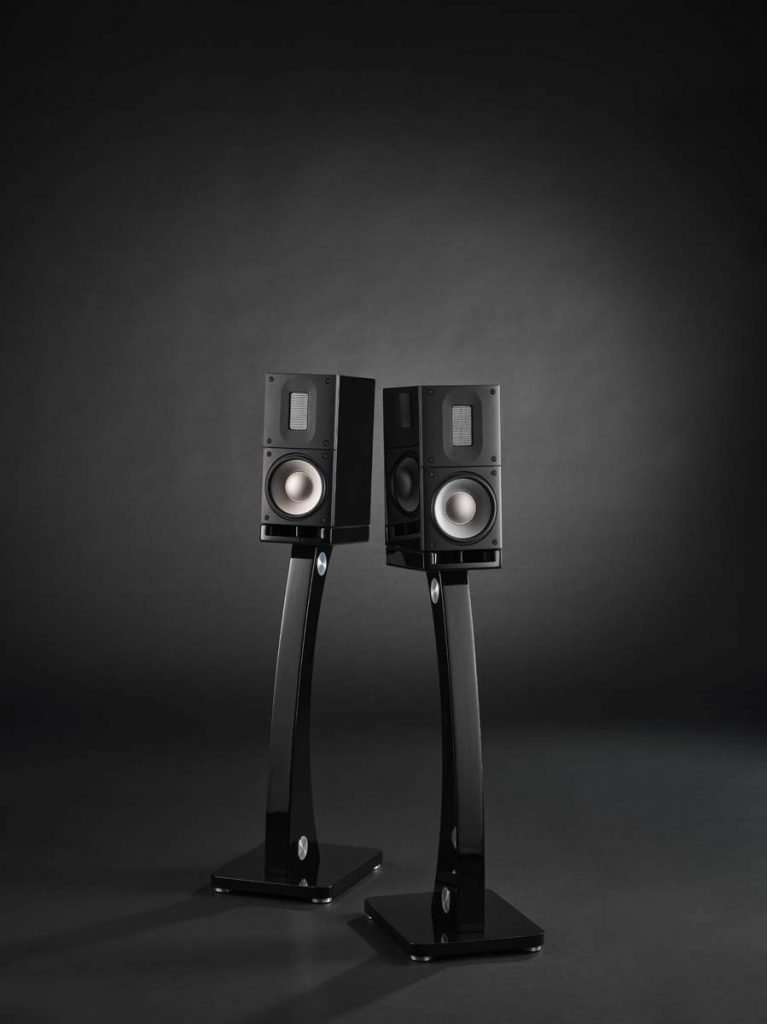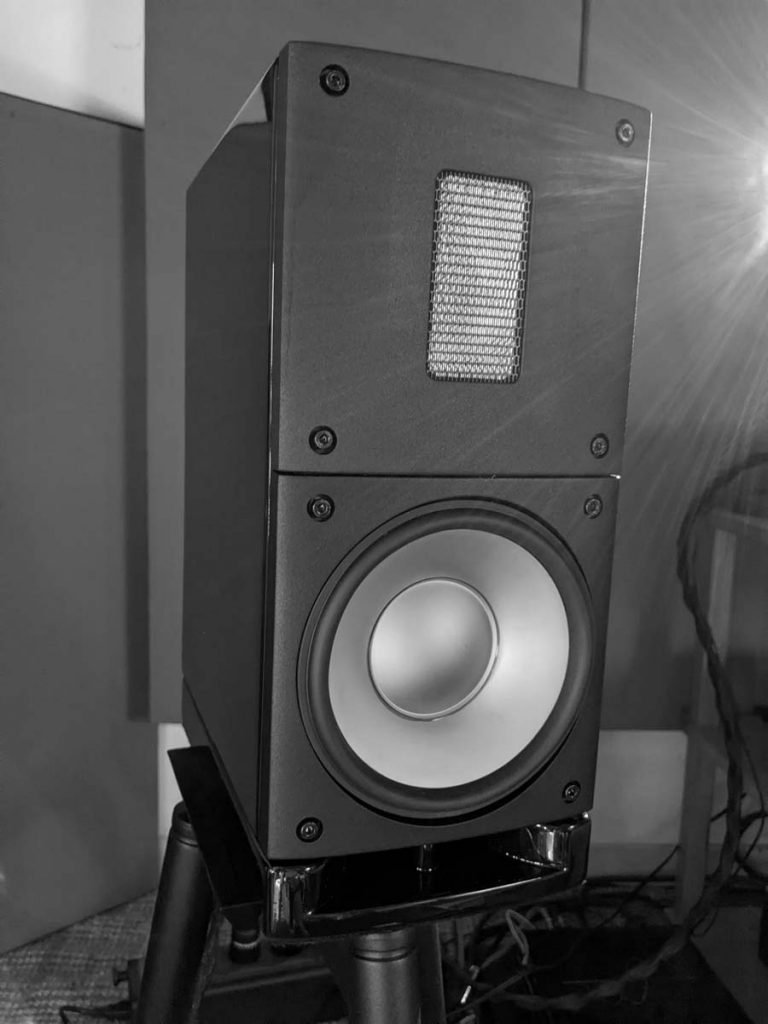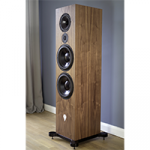RAIDHO X1T LOUDSPEAKERS REVIEW
Raidho X1T is a two-way mini-monitor using a Tantalum coated mid/bass driver and a sealed ribbon tweeter – they cost €5800.
Dantax took over the running of Raidho loudspeakers in 2009, though Dantax was founded in 1972 when they made speakers under the Dantax banner. Interestingly Dantax also owned (between 1977 and 1980) the renowned driver manufacturer Scanspeak. Dantax is now focused very much on the higher-end of the audio-marketplace and own the brands Scansonic and GamuT, as well as Raidho, all of which are made in Denmark.
My experience of Raidho at home and in our review systems is limited to a review of the excellent TD2.2 which I reviewed here and which I had no option other than to give our Editor’s Choice award. The TD2.2 are a floorstander costing £38K and what I particularly loved about them was their balanced approach to the way they played music, allied with a wonderful spatial interpretation of the music which I put down to the use of the Tantalum Diamond Ribbon (Planar Magnetic) tweeter – the driver on the speakers we have here is not Tantum or Diamond coated but is a sealed planar unit. I didn’t have 38K to spunk on a pair of speakers at the time but had I they would have been a permanent fixture in our main listening room. I can only imagine what the range-topping TD6 would sound like in our room, though I have heard them at Munich back in May along with €7300 X1.6 and the X1T’s we have here. Actually, I thought the real standout (with regards to price/performance) of the three at Munich was the X1T. However, you can’t properly review speakers or any other kit at shows as the only meaningful reviews happen with the kit you know and with music you know well and so I was delighted when we were asked to review this particular pair of speakers.
RAIDHO XT1 BUILD AND FEATURES
The X1T from Raidho is essentially the same as the company’s X1 loudspeaker and uses the same sealed ribbon tweeter, but with Tantalum coated ceramic mid/bass drivers. They are ported to the front with a slot port and arrived in a wonderfully glossy piano black finish, though they are available in white too. A dedicated (and lovely looking) stand is available and there is provision to bolt the speakers to those stands. However, no stands were provided for the review and I used Solidsteel speaker stands for the duration. The bottom of the speakers have a felt protective layer to avoid scratching and I liked this small attention to detail.
The speakers are a two-way design measuring just 145mm wide and 320mm high and so really are quite diminutive, and this, of course, is reflected in their frequency response which is quoted as being 70Hz -50kHz. That 70Hz figure may well alarm some people and given the kind of music I enjoy most (bass-heavy techno) I fully expected to need to use a sub in our largeish second listening space – we’ll see as the review process progresses on that front, though they will be used without unless otherwise stated.
The X1T are 85dB sensitive and a 6ohm load (it never falls below 5.8ohms Raidho tells us) so I hooked them up to our Merrill Thor Class Ds which kick out 300W a side, though Raidho suggests that a quality 50W amp should be ok and that they have used smaller valve amps with good results – again, this is something I can test with our English Audio C21 20W valve amp.
Finish, as I’ve alluded to, is really gorgeous, and whilst the speakers don’t come with covers I don’t think you’d want to be hiding them from view. I think they are a real statement of design and whilst they obviously look like a pair of loudspeakers they are very handsome, though less masculine than that particular adjective would suggest.
Around the back of the speakers is a simple but good-quality pair of binding posts.
The speakers come with a five year warranty which is reassuring and they arrived well packed and with a well-written owner’s pamphlet that covers unpacking, suggestions of suitable amps, break-in, and placement. There is also a warning in the pamphlet to tell you to remove rings and watches so as not to scratch the speakers when handling them and also a warning not to touch the delicate diaphragm of the tweeter – and a note to say that damage to the tweeter by “physical abuse” is not covered by the warranty.
Raidho suggests positioning the X1Ts at least three feet from the back wall but also suggests that they can be placed pretty close to side walls. They also suggest the speakers should be placed between 9 and 12 feet apart and that they do like to be placed far apart, though 6-8 feet from the plane between the speakers. I had them 2,93m (9.6 feet) apart and I was sat 2,4m (7.9 feet) from the plane between the speakers. They were 1m (3.3 feet) from the back wall and around 1m from the side walls. The speakers were angled directly at either side of my head. The room is treated to the sides, corners, and roof with GIK panels and bass traps. I did find it useful to get the laser measurer out and ensure the speakers were exactly the same distance from the listening position and if you do end up buying these then I would suggest you spend a bit of time to get the positioning “just so” as I found imaging really did snap into place when accurately done.
Anyway, the speakers arrived and were placed in the upstairs system as per the above measurements and allowed to run in for a couple of days, though Raidho does suggest they will really come on song after 250 hours.
The system I used was LAB12 DAC and Pre, Merrill Thor amps, and an Auralic Aries G1 running Roon and Qobuz. Cables were by Atlas, Tellurium Q, and LAB12. Speaker stands were by Solidsteel and a LAB12 power conditioner was used. This is about the level of gear I would expect a pair of speakers at this price point to be partnered with.
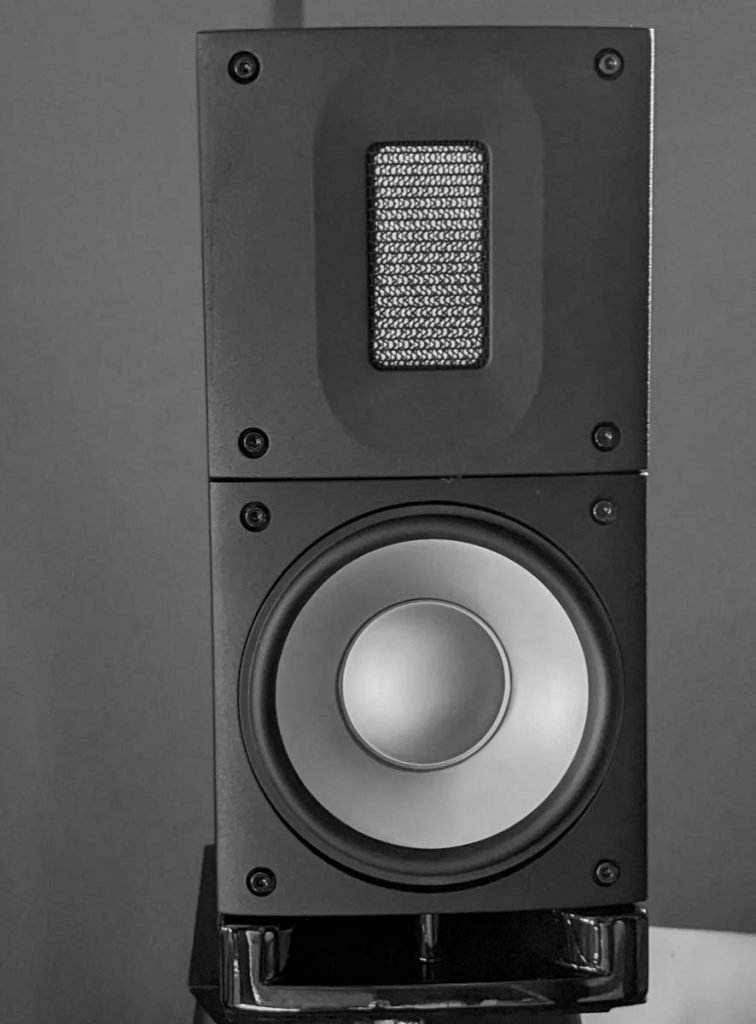
The Raidho X1T from the front and showing the ribbon tweeter and Tantalum coated mid-bass driver and front port.
LISTENING TO THE RAIDHO X1T LOUDSPEAKERS
As I mentioned earlier I thought the X1Ts were the standouts for me at the Munich High End, but I will say now that I was a little worried about how they would perform in the real world and in our medium-sized second listening space. There’s no getting away from the fact that these are mini-monitors and with that comes limitations on their performance at lower frequencies – Raidho themselves say that these speakers only go down to 70Hz. However, there are a lot of things quality mini-monitors get very right and the truth of the matter is that after a period of time your ears/brain becomes accustomed to the lack of absolute bass performance and you really don’t miss it – I say that as a dyed in the wool basshead. I’m also of the mind that many people are inclined to put speakers that are too big in rooms that are too small to cope with them and this brings its own problems with regards to bass bloom and a misbalanced sound. I’ll talk a bit more about the bass performance of these a little later.
What the Raidho X1Ts immediately get right is a wonderful sense the stereo image. Towards the end of the review process, I was playing the new Hot Chip record and, even though the record was new to me, it was easy for me to be able to pull the mix apart in a spatial sense – instruments and sounds in the mix are pin-point sharp and placed. In addition to this there is left-to-right and front-to-back spatiality… and also height – there’s a bit towards the Freakout/Release track on this record which has a percussive upper-bass line and this appears to come from bang central in the mix but also has incredible height. Looking at my notes at this point I read that I’ve noted that the speakers “disappear” and whilst I may well have scoffed at this notion in the past it is a pretty accurate statement to make with regards to the Raidhos. The TD2.2s we had in for review also had this ability to disappear and this is no doubt down to the use of the ribbon tweeter and its implementation.
Whilst I’m talking about the tweeter it is worth mentioning that whilst amazingly detailed in what it conveys to the listener, this tweeter is in no way harsh or over-exaggerated or tiring to listen to over long periods – Raidho has managed to pull off an uber-detailed treble that also sounds smooth. I know this latter point seems to make statements that conflict, but whilst the upper frequencies are well extended, they are not piercing. I’ve said before in reviews that some manufacturers can use an over-exaggerated high-frequency performance to create an illusion of detail but this “trick” can soon become too much and you soon tire of the loudspeaker – not so the X1Ts!
Moving onto the mid-band and I keep wanting to reach for the word smooth, but I really don’t think that is the right word to use as it conveys, as I mentioned whilst mentioning the treble performance, a sense that there is a degree of “rounding off” going on, and that just is not what is happening here. Again, there is a sense of rightness with regards to the mid-band performance with the X1Ts. Listening to BBC Radio 4, spoken word sounded natural and without any trace of sibilance.
Bird Radio’s J.T/Here Lies Old Bones from the album Oh Happy England is predominantly voice and this is projected out into the room and very dynamically rendered, with these speakers representing brilliantly when the vocal goes down to a whisper. There’s no lack of detail and the timbre and texture of his voice comes across really well -even the ever so slight “soft R” inflection. If you don’t know Bird Radio then you should check out this record or the album The Boy and The Audience (there are others now available). This is a real treat on these loudspeakers and I can imagine them being used in the studio given their perceived accuracy and lack of colouration through the vocal range.
Let’s move on to the bass department and what would at first glance seem to be mini-monitors’ Achilles Heel. I’ve already mentioned in my preamble that no mini-monitor is able to go low, but I’ve also said that in many homes too low a bass and too big a speaker can cause as many problems as it attempts to cure. Yes, the Raidhos are limited in their lower bass response, that’s just physics, but as I mentioned you do get used to this over a very short period of time. The opening to Dusty Kid’s Dusty Kid III begins with a very low and rumbling and modulating bass noise and whilst you aren’t getting the same visceral quality I’m used to with our bigger speakers, there is still enough of the texture and “idea” of the bass to make the track enjoyable (this is another must-have record, by the way!). There’s a part in this bass line intro that falls away to a whooshing sound and the speakers convey this very well. On tracks such as Hardfloor’s Acperience 1 the bass kick lacks the degree of whoomph I’m used to on our larger speakers, but the TB303 sounds very correct, despite lacking the lower registers.
Overall and from top to bottom the Raidho X1Ts are an incredibly well-integrated loudspeaker that can’t help but bring a smile to your face.
ADDING A SUB
Plumbing in a REL t5i sub (you can pick these up in the UK for a frankly ridiculous £250 at the moment) and getting it dialed in correctly certainly adds to the weight of the bottom end whilst taking nothing away from the other characteristics of the X1Ts – it does make for a proper full-range listening experience and if your room can handle the extra bass then I believe this to be a worthwhile addition for not a lot of dosh. Listening to the same Dusty Kid track (Crepuscolaris) as I did earlier, that introduction is fleshed-out whilst losing none of its detail. In fact, it was quite a spectacular listening experience with me getting enveloped in the dramatic soundscapes and textures. I actually REALLY enjoyed the addition of the sub to these speakers which is unusual for me and I did actually begin to wonder if this kind of setup wouldn’t be perfect in this space – something that hasn’t really crossed my mind before. At volume, this partnership was absolutely fantastic! My comment via messenger to Linette who was working elsewhere in the house was “Get yourself up here and listen to this, it’s fu&^ng incredible!”
USING A VALVE AMP
Raidho suggests an amp of 50W a channel or more, but also say that lower powered valve amps perform well and so this had to be tried out with our English Acoustics 21C. Yes, the amp undoubtedly works and you do get to hear the small nuances that the amp brings to the party, but (for me) I preferred the added clout and headroom that the Merrill Thors allowed.
QUIBBLES
They are small speakers and don’t do bass below 70Hz!
Price will no doubt put some off – read this.
No grille, but would you want to hide these away?
CONCLUSION
If you are determined to buy a pair of mini-monitors then you could do a lot worse than spending your dosh on these. Yes, there are limitations in the bass department, but you need to accept that that’s just how small speakers behave given we can’t do anything about physics and that what they lack in bass they make for in other ways such as impeccable imaging and top to bottom integration. Anyway, if you do buy these and do feel you want that “full-range” experience then whack a sub on them and hide it away. Job sorted!
These speakers image like absolute stars and in that respect they are absolutely superb. They also disappear into the background and allow you to get lost in the musical image that is laid out before you.
As well as the superb imaging there is a sense of rightness about these speakers and whilst some speakers may impress with a pushed top end to simulate detail, that is not what you get with the Raidhos and there is no sense of listener fatigue setting in, even after extended listening sessions.
The Raidhos have a sense of speed and agility to them that is hard to describe, but you are aware of it when listening intently to them. This speed and agility, allied with their incredibly low colouration, makes for an exceptional listening experience that is fantastic (though obviously limited in bass) in its own right and brought to another level with the addition of a (cheap) sub – something I certainly didn’t think I’d be writing!
At the end of the day all mini-monitors are going to be judged on how they perform against a pair of BBC LS3/5As and, for me, the Raidhos trounce the BBCs and bring the mini-speaker bang up to date – as they should given the price difference.
I often finish off a review with the question “Would I buy them?” and the answer here is a definite yes, though for me and in this sized room I did appreciate the addition of a sub and this is without a doubt the best experience of small speaker/sub I have ever experienced. In smaller rooms I doubt anyone would need or even appreciate having a sub added.
I genuinely didn’t want to take these out of the system and I have no option other than to give them our top award, with the caveat that I realise they are a luxury and therefore expensive product.
AT A GLANCE
Build Quality:
Impeccable looks and build
Sound Quality:
Speed and detail throughout the available frequency range
Fantastic top end detail that never becomes tiring
Wonderful with spoken word and vocally led music
The speakers do disappear leaving you with a three-dimensional image that reminded me of the early (and great) Audio Physics and their walk-in soundstage that extends well beyond the speakers’ sides and projects front and back – very much like the previous Raidhos I reviewed
Uncoloured and clean sounding
Value For Money:
Here is where I’m going to get people moan and tell me that £5800 for a pair of mini-monitors is daft. However, get yourself in front of a pair, forget the price and just fall into their sound
We Loved:
An immersive and detailed presentation that never becomes tiring to listen to
We Didn’t Love So Much:
In a larger room, a sub does help a great deal
They aren’t cheap
Price: €5800
Elevator Pitch Review: Danish brand Raidho’s X1Ts are tiny speakers that will be easily accommodated in any smaller room and in these situations will offer listeners a fantastic top to bottom experience without over-exciting bass. They have the ability to disappear and throw a soundstage that is wide, deep, and has height. Yes, they have limited bass response as all speakers of this size do, but the frequencies they do put out are incredibly well integrated and this leads to a very natural and uncoloured sound. I really, really enjoyed these speakers, especially with the addition of a cheap sub in our room.
Stuart Smith
RAIDHO X1T SUPER MINI MONITOR SPECIFICATIONS:
Size, mm. (BxHxD): 145 x 320 x 230
Weight, kg.: 8
Freq. response: 70 Hz – 50 KHz
Impedance: >6 ohm
Sensitivity: 85 dB 2.83 V/m
Crossover: 3.5 kHz
Enclosure: Vented design. Port in front panel
Drive units: 1 x sealed ribbon tweeter. 1 x 5,25” Ceramic and Tantalum driver
Finish: Black piano and White piano
Amplification: >50 W (Though we have seen excellent results with small tube amplifiers)














































